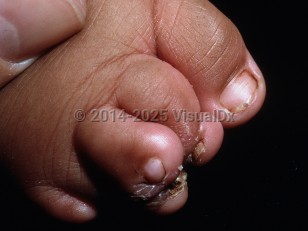Pseudoainhum is a very rare condition in which a constriction band forms around a digit or extremity. Unlike ainhum, in which digital constriction bands develop spontaneously, pseudoainhum occurs in the setting of an underlying cutaneous condition or initiating factor.
Amniotic bands may cause congenital pseudoainhum. Acquired pseudoainhum can occur after external trauma from a hair or thread wrapped around a digit, or in association with an inherited palmoplantar keratoderma, such as Vohwinkel syndrome, Olmsted syndrome, Mal de Meleda, loricrin keratoderma, Papillon-Lefèvre syndrome, and KLICK syndrome (keratosis linearis with ichthyosis congenita and sclerosing keratoderma). Additionally, pseudoainhum has rarely been reported to coexist with psoriasis and lamellar ichthyosis.
Pseudoainhum typically affects the digits. It can present in one of 4 stages: an asymptomatic groove of constricting soft tissue (stage 1); ulceration of the floor of the groove (stage 2); bony erosion (stage 3); and spontaneous autoamputation (stage 4). The disease typically progresses between stages slowly over months to years, but a more rapid progression over days has been reported.
Pseudoainhum in Adult
Alerts and Notices
Important News & Links
Synopsis

Codes
ICD10CM:
L94.9 – Ainhum
SNOMEDCT:
19988008 – Pseudoainhum
L94.9 – Ainhum
SNOMEDCT:
19988008 – Pseudoainhum
Look For
Subscription Required
Diagnostic Pearls
Subscription Required
Differential Diagnosis & Pitfalls

To perform a comparison, select diagnoses from the classic differential
Subscription Required
Best Tests
Subscription Required
Management Pearls
Subscription Required
Therapy
Subscription Required
References
Subscription Required
Last Reviewed:09/02/2021
Last Updated:09/08/2021
Last Updated:09/08/2021
Pseudoainhum in Adult

